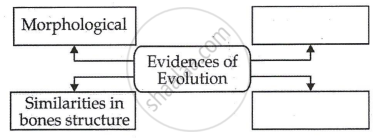Advertisements
Advertisements
Question
Pick the odd man out:
Options
duckbill platypus
pomfret
lungfish
peripatus
Solution
pomfret
Explanation:
In Peripatus, characters like segmented body, thin cuticle, and parapodia-like organs are present. Similarly, duck-billed platypus lays eggs like reptiles but shows relationships with mammals too due to the presence of mammary glands and hairs. Lungfish perform respiration with lungs, irrespective of being fish. These examples indicate that mammals are evolved from reptiles and amphibians from fish.
APPEARS IN
RELATED QUESTIONS
Which of the following is a correct set of homologous organs?
(a) Forelimbs of frog, bird and lizard
(b) Spine of cactus and thorn of bougainvillea
(c) Wings of bat and wings of butterfly
(d) Wings of a bird and wings of a bat
Which one of the following pairs of vegetables is an example of homologous structures?
(A) Potato and sweet potato
(B) Carrot and radish
(C) Carrot and tomato
(D) Tomato and radish
Four students P, Q, R and S differently reported the following set of organs to be analogous :
P. Forelimb of a frog and forelimb of a lizard
Q. Forelimb of a bird and forelimb of a human
R. Wings of a parrot and wings of a butterfly
S. Wings of a bird and wings of a bat
The two students who have reported correctly are :
(A) P and Q
(B) Q and R
(C) R and S
(D) P and S
Enlist any four sequential evolutionary names of human ancestors.
Name two animals having homologous organs and two having analogous organs. Name these organs.
Wing of an insect and forelimb of a bird are :
(a) analogous organs
(b) analeptic organs
(c) homologous
(d) homophobic organs
You have potato, carrot, radish, sweet potato, tomato and ginger bought from the market in your jute bag. Identify two vegetables to represent the correct homologous structures.
(A) Potato and tomato
(B) Carrot and tomato
(C) Potato and sweet potato
(D) Carrot and radish
Write short notes based upon the information known to you.
Connecting link
_______ is a connecting link between Annelida and Arthropoda.
The most common types of fossils are ------------------------.
Draw a labelled diagram of T.S. of a leaf showing Kranz anatomy.
Explain any three molecular (genetic) evidences in favour of organic evolution.
Define phylogeny.
Answer the following question:
What are homologous structures? Give an example. Is it necessary that homologous structures always have a common ancestor? Justify your answer.
Short answer question.
Give the significance of fossils.
Similarities in the initial stages indicate the _______ evidence.
_____________ is a vestigial organ in human beings.
What is carbon dating?
Biogenetic law states that ______.
The degenerated and non-functional organs found in an organism are called ______.
A human hand, a front leg of a cat, a front flipper of a whale and a bat’s wing look dissimilar and adapted for different functions. What is the name given to these organs?
Select the CORRECT match.
Cucurbits do not develop thick and woody stem as they are:
Evolutionary convergence is the development of:
The study of fossil evidence of evolution is called ______
What were the characteristics of life forms that had been fossilised?
Did aquatic life forms get fossilised? If, yes where do we come across such fossils?
Complete the following chart:

Find odd one out:
Write down the difference between homologous and analogous organs.
Find the odd one out:
Explain natural selection with the example of industrial melanism.
Evolutionary convergence is the development of a ______.
Industrial melanism in England after 1850 is an excellent example of Natural selection. Explain how?
Complete the following conceptual picture:

